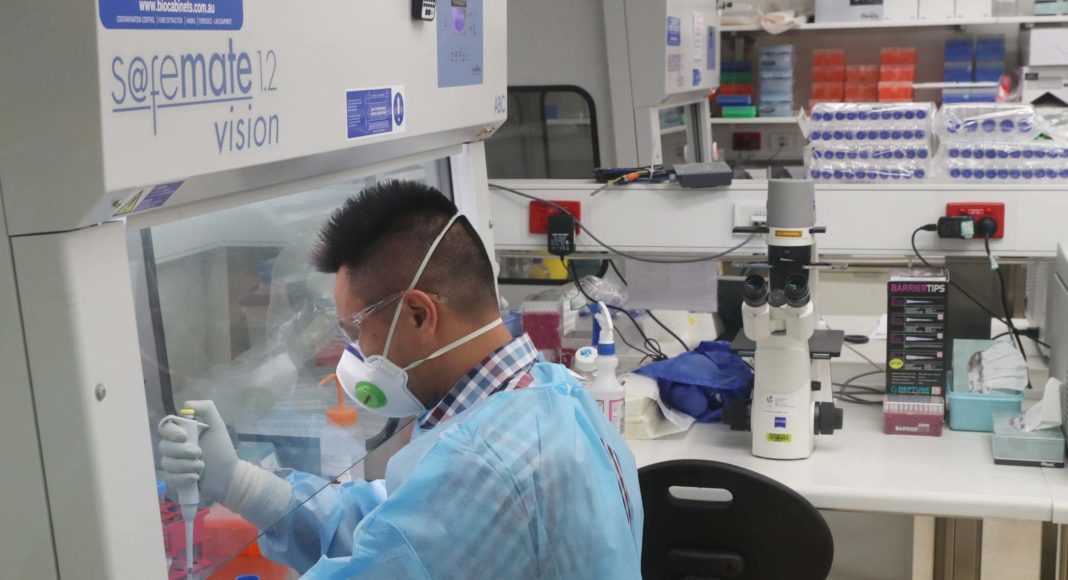A potential coronavirus vaccine has been developed by scientists in Australia.
The team at the University of Queensland will start animal testing this week and hope to begin clinical trials on humans by the middle of the year.
The breakthrough was announced by Professor Paul Young, head of the university’s school of chemistry and molecular biosciences, as the number of known cases soared to nearly 78,000 worldwide and the death toll reached 2,355.
Download the new Independent Premium app
Sharing the full story, not just the headlines
Download now
He said the team of 20 had been working “around the clock” to speed up the process, identifying and replicating a key protein in the virus – which forms basis of their vaccine candidate – within just three weeks.
“There is still extensive testing to ensure that the vaccine candidate is safe and creates an effective immune response, but the technology and the dedication of these researchers means the first hurdle has been passed,” said the university’s vice-chancellor Peter Hoj.
left
Created with Sketch.
right
Created with Sketch.
1/10 Coronavirus outbreak in Daegu
The near-deserted streets of Daegu’s Dongseongro shopping district
AFP via
2/10 Coronavirus outbreak in Daegu
People line up to buy foods and supplies at a supermarket in Daegu
AP
3/10 Coronavirus outbreak in Daegu
A beggar wearing a mask to prevent contracting the coronavirus is pictured on Dongseongro shopping street
REUTERS
4/10 Coronavirus outbreak in Daegu
Shopkeepers on Dongseongro shopping street in central Daegu
REUTERS
5/10 Coronavirus outbreak in Daegu
Women wearing masks in Daegu’s Dongseongro shopping district
REUTERS
6/10 Coronavirus outbreak in Daegu
Medical workers wearing protective gear transfer a suspected coronavirus patient (C) to hospital
YONHAP/AFP via
7/10 Coronavirus outbreak in Daegu
South Korean health officials spray disinfectant in front of the Daegu branch of the Shincheonji Church of Jesus
AFP via
8/10 Coronavirus outbreak in Daegu
South Korean health officials spray disinfectant
AFP via
9/10 Coronavirus outbreak in Daegu
A South Korean man wears a protection mask while walking in central Daegu
EPA
10/10 Coronavirus outbreak in Daegu
A South Korean health official sprays disinfectant front of a hospital
YONHAP/AFP via
1/10 Coronavirus outbreak in Daegu
The near-deserted streets of Daegu’s Dongseongro shopping district
AFP via
2/10 Coronavirus outbreak in Daegu
People line up to buy foods and supplies at a supermarket in Daegu
AP
3/10 Coronavirus outbreak in Daegu
A beggar wearing a mask to prevent contracting the coronavirus is pictured on Dongseongro shopping street
REUTERS
4/10 Coronavirus outbreak in Daegu
Shopkeepers on Dongseongro shopping street in central Daegu
REUTERS
5/10 Coronavirus outbreak in Daegu
Women wearing masks in Daegu’s Dongseongro shopping district
REUTERS
6/10 Coronavirus outbreak in Daegu
Medical workers wearing protective gear transfer a suspected coronavirus patient (C) to hospital
YONHAP/AFP via
7/10 Coronavirus outbreak in Daegu
South Korean health officials spray disinfectant in front of the Daegu branch of the Shincheonji Church of Jesus
AFP via
8/10 Coronavirus outbreak in Daegu
South Korean health officials spray disinfectant
AFP via
9/10 Coronavirus outbreak in Daegu
A South Korean man wears a protection mask while walking in central Daegu
EPA
10/10 Coronavirus outbreak in Daegu
A South Korean health official sprays disinfectant front of a hospital
YONHAP/AFP via
“It started back when China released the sequence back in late January. That gave us the viral genome we needed to take and express,” Prof Young told a press conference on Saturday.
“A key milestone is actually generating the vaccine prior to putting it into animal studies – we will be going into our first animal studies at the University of Queensland this week.”
While it can take 18 months before any vaccine is ready to be distributed to the public, Prof Young said this process could be accelerated if there are assurances the safety of clinical trials would not be compromised.
Read more
The researchers are funded by the global Coalition of Epidemic Preparedness, as part of a programme to develop rapid vaccine responses to viral outbreaks.
The team uses technology called a “molecular clamp” to help create the protein used in the vaccine, a process it believes makes the vaccine more likely to be recognised by the immune system.
“We’ve been using this technology to produce vaccines for some of the world’s biggest viruses including Ebola, Mers coronavirus and nipah,” said Dr Keith Chappell. “But this technology is also designed to be able to quickly respond to a currently unknown virus.
No hype, just the advice and analysis you need
“We’ve put together a group of some of Australia’s leading academic institutions, with the goal of reducing the time required for vaccine development down from multiple years to a matter of weeks.”
There are several major efforts to develop a vaccine happening around the world, most of which use the faster but potentially less effective method of gene sequencing, rather than building the protein from scratch, Prof Young said.
As a result of this, he said it was hard to tell whether theirs was the first potential vaccine to be developed for the coronavirus, which has been formally named Co-19.
“The best thing that can happen is happening now – that is, there is a wide number of groups working toward vaccine approaches, and quite frankly the first one that gets there, it will be great,” Prof Young said. “It is not a race between vaccine producers, it is a race against this particular virus.”
He added: “It is a new territory for vaccine design. Vaccines take many years to develop from concept to licence and use in the community.
“What we are aiming for is somewhere between 12 and 18 months, which is remarkably quick.”




